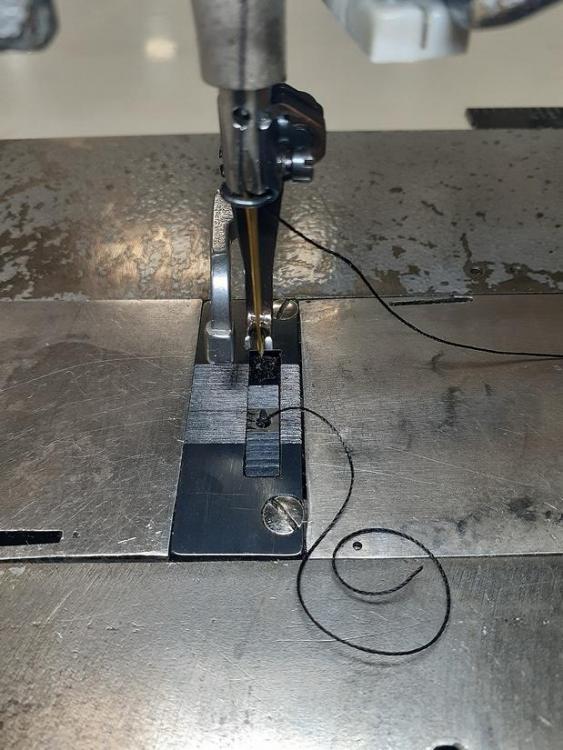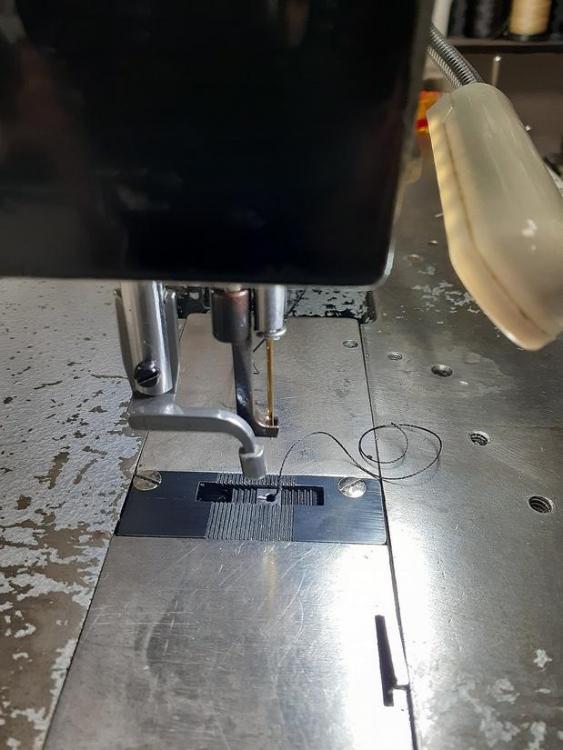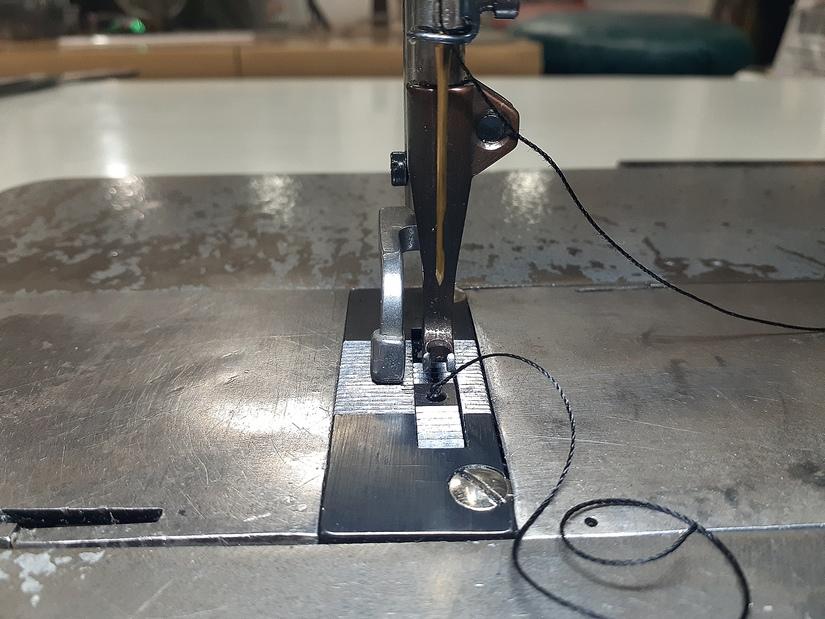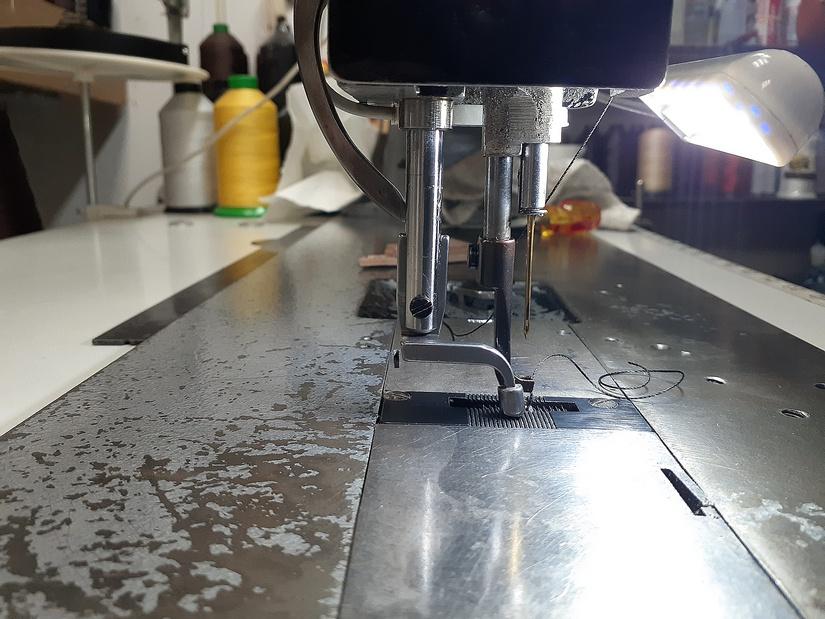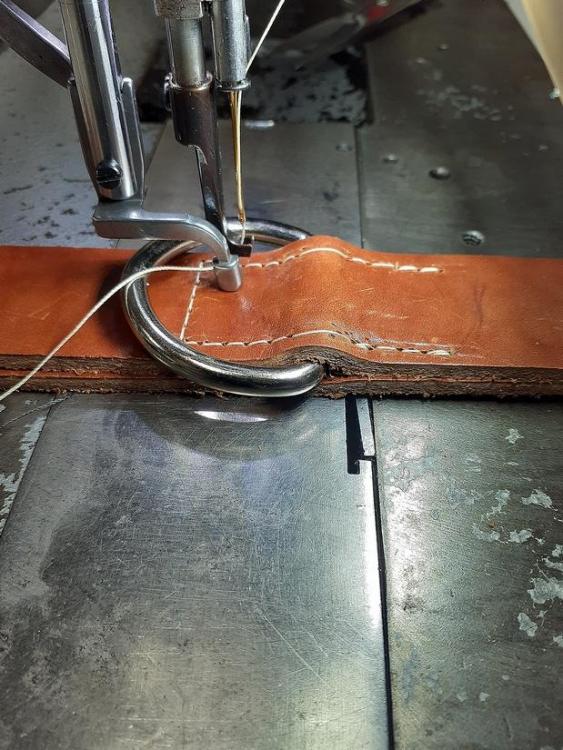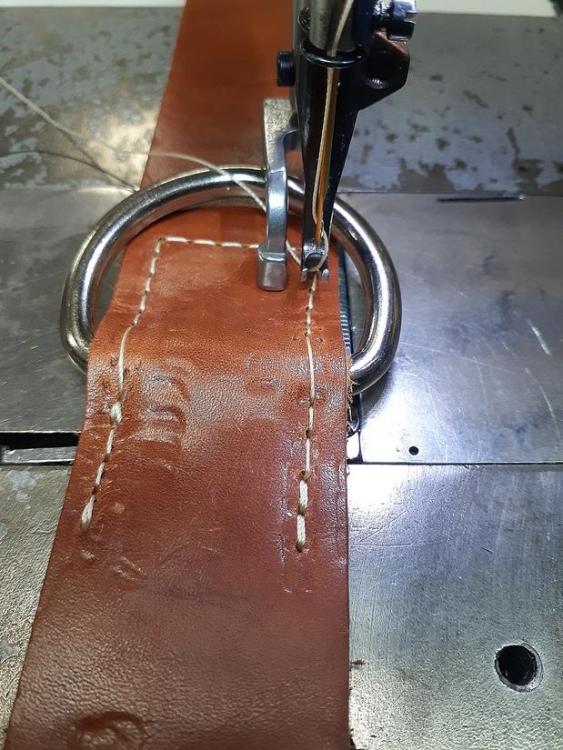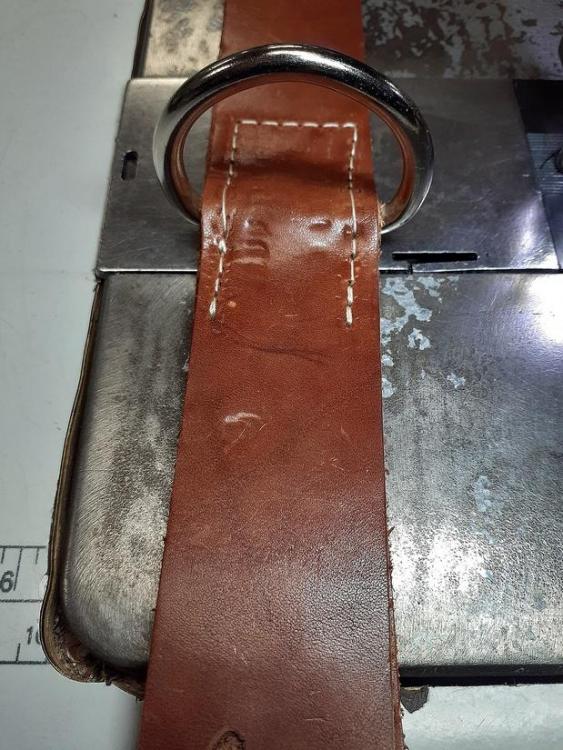-
Posts
7,761 -
Joined
-
Last visited
Content Type
Profiles
Forums
Events
Blogs
Gallery
Everything posted by Wizcrafts
-
Search for a Singer 111w155. It is a compound feed walking foot machine that can sew up to 9 or 10mm (20-24 ounces) if properly setup. It uses a medium size G style bobbin and should be limited to Tex 135 and smaller thread. It takes the common System 135x16 (leather) and 135x17 (cloth) needles. They are workhorse machines that keep on going and going. Check with local upholstery shops to see if they have one they will let go of.
-
Yes, the 132k6 has an early foot walking foot design: a spring loaded follow foot that moves as the feed dog pushes the material on the bottom. The inside foot acts as a needle guide and moves up and down as the outside foot moves back with the material. They were originally meant to sew 1/2 inch thick cotton or canvas buffing wheels using a special spiraling attachment. Despite the massive case and huge bobbin, it is not a leather sewing machine. I learned that the hard way.
-
Apparently, some of the 132k10s have roller presser wheels. See this page for an example. It will definitely improve the feeding vs a flat foot. I used to have a 132k6 and it had trouble sewing 1/4 inch of veg tan with #346 thread using a #26 needle. It did a better job on cloth and webbing. But, I was inexperienced at that time and I didn't know about #277 thread, or if anybody sold it. My solution was to sell it and buy a more capable leather stitcher.
-
I didn't have much time to play with the buckle foot, but it leaves a deep round foot impression in bridle leather. I tested it sewing on a large steel dee ring. It does get over the back bar with ease. I wouldn't recommend it for bridle or moist veg tan. Maybe bison or chap would hide the marks better. However, the foot is about 1/4 inch from the needle. There is a gap of 1/8 inch on the left of the inside foot. It could have been closer in my opinion. Or, a wider inside foot supplied.
-
I just got a buckle jumping foot from KP last week (it took a month on a slow boat from China). I haven't tried using it yet, but will when I go to my shop. I'm not sure what it is made to accomplish. I'll have to figure that out. I think it might be designed to sew before and after inline buckles or Dees. I can tell you it looks well made and included a narrow inside foot. I'm dubious about the claim it is for sewing zippers. I use a left toe, or narrow double toe foot for those.
-

Consew 206RB-5 Table Cut-Out Pattern
Wizcrafts replied to DavidBraley's topic in Leather Sewing Machines
I am curious. Why did you make that poor decision? You can still buy a knocked down table that is setup for your make and model. It will save a lot of time, mess and probably money too. Most tables include a proper machine cutout with countersunk supports at the four corners, a slot for the belt, a K or H legs steel frame, a motor, a switch box and wiring, a proper length v-belt, a floor pedal and linkage for the motor, either a knee lifter assembly or foot lifter and chain with a cutout in the table, a bobbin winder, a drawer, an oil drip pan with a cutout for a knee lifter (or a fitted and gasketed oil pan for oil pump equipped machines), a thread stand, a tilt back peg and a flex lamp. -

Consew 206RB-5 Table Cut-Out Pattern
Wizcrafts replied to DavidBraley's topic in Leather Sewing Machines
That is because the owner died in March of 2021. The website is still registered until 2023, but all pages now render a 403 Forbidden response. All content has been removed or is concealed. -
First try timing it with System 134-35 needles. They are frequently used in Pfaff machines. The System 190 are much longer and would be used on high lift machines to allow one to sew thicker material. You could check if your model was originally a high lift, or standard lift. "Lift" in this instance means alternating foot height during operation.
-

The purpose of left stand sewing machines
Wizcrafts replied to Constabulary's topic in Leather Sewing Machines
Has anybody considered the possibility that the left hand machines, like my Singer 18-2, are for sewing left shoes or left cuffs only? They could use an identical right handed machine to sew the other shoe or cuff. It makes sense to me. But, I'm not right! -
Here's the motor you need, with a control pedal.
-

Can you identify an Adler model 30-? from a photo
Wizcrafts replied to mygnnss's topic in Leather Sewing Machines
Thanks for that info. I didn't know that. -

Can you identify an Adler model 30-? from a photo
Wizcrafts replied to mygnnss's topic in Leather Sewing Machines
If you can get a picture of the shuttle it will reveal whether it is a -1 or -7. I have a 30-7 which looks exactly like this machine and has a large bobbin and shuttle. The nose is 1.25 inches wide to accommodate the large shuttle. The 30-1 has a small bobbin and is only 1 inch wide at the nose. As for the price, I'm in the USA and paid $1300 USD for my 30-7, so $1600 CDN isn't such a bad price. These are heavy duty patchers and will pay for themselves sewing patches onto bikers' vests. They can fix purses, sew cue cases, hem sleeves, replace zippers in jackets and chaps and sew shoe and boot uppers. If this patcher uses the long System 332LLG needles, it can sew 3/8 inch under the foot! -
@Willie0, If you really need to sew up to 1/2 inch seams, with #138 thread, I think you should look at the Juki LU-1508NH. Price it setup with System 190 needles which are 3/16 inch longer than standard walking foot needles. Setup as such, the NH can actually sew 1/2 inch seams.
-
That is a toy motor for household/domestic sewing machines. I looked up the 66-18 and it is a domestic sewing machine. It is meant to sew thin cloth. You can probably upgrade the feeble motor with a 1.5 amp model sold on eBay. Get a new controller with it. Don't expect professional results from a domestic sewing machine.
-

Used Pfaff 1245, questions before buying
Wizcrafts replied to Null's topic in Leather Sewing Machines
Upholstery class machines will not sew holsters and sheathes. For those you will need a holster/harness stitcher. What's available depends on your location. Your IP address says Norway. Your profile is blank. -

Used Pfaff 1245, questions before buying
Wizcrafts replied to Null's topic in Leather Sewing Machines
A fair price is what you are willing to pay. Look it up and see what they are selling for in your general area. Offer 1/2 and see where it goes. Normally, upholstery machines are run at top speed. They typically ship with heavy clutch motors. These motors spin and draw power as long as they are turned on. This generates heat and runs up your electric bill. You can learn to feather the clutch to sew slowly. Servo motors serve two purposes. 1: little to no current draw until you run them under load. 2: easier to control at slow speeds. They are also much lighter in weight. If the machine suits your projects it is as good as any. You never said what you want to sew. -

29u171 handwheel mounting question
Wizcrafts replied to arianmanchego's topic in Leather Sewing Machines
I will leave this open in case other members need the same parts. -
@Tequila Try to remember to hold back the starting threads, equally if possible, to lock and center the first stitches and keep the top thread from getting wrapped around the shuttle, jamming the machine and possibly throwing it out of time.
-

Cobra 26 presser/walking foot marking up leather
Wizcrafts replied to AtomicLeathers's topic in Leather Sewing Machines
Some compound feed walking foot machines have a second spring (and an adjuster) over the inside foot. If your Class 26 has that adjuster, back it off as far as it will go. You can even eliminate the spring on that foot if the adjuster doesn't clear them. Otherwise, try to find a softer presser foot spring. The only machines I have owned or sewn on that don't leave marks around the needle are needle and awl machines, like the Union Lockstitch and Randall Lockstitch, and shoe patchers. These are jump foot machines with one presser foot that has legs outside the needle position. Unfortunately, patchers leave tooth marks from the foot, unless you cover them with heat shrink tubing (reducing the feedability). -

A few questions about a new to me 810 post bed
Wizcrafts replied to Landcruzer94's topic in Leather Sewing Machines
There is a drop-down speed reducer sold by Toledo Industrial Sewing Machines. It sits under the table in place of your motor, which gets attached to the bottom of the reducer box. I have this box installed on two of my machines. It works great! -

Cobra 26 presser/walking foot marking up leather
Wizcrafts replied to AtomicLeathers's topic in Leather Sewing Machines
Ask Cobra if they can mail out a softer spring, or one that is already cut down and polished on the ends. There are soft and hard pressure springs for many types of machines. Some may be meant for a different brand but may fit in yours. -

Advice on selling my Cowboy 3500 please
Wizcrafts replied to Tallbalde's topic in Leather Sewing Machines
A 3 year old machine is used no matter how little use it got. You will probably end up selling it for half what you paid for it. As for price increases, you can use it to justify whatever price you choose to list it at. If you want to sell it here, please place an ad in our Marketplace section, under sewing equipment > used. Show a photo of the machine and accessories, its location, your terms and your price.



